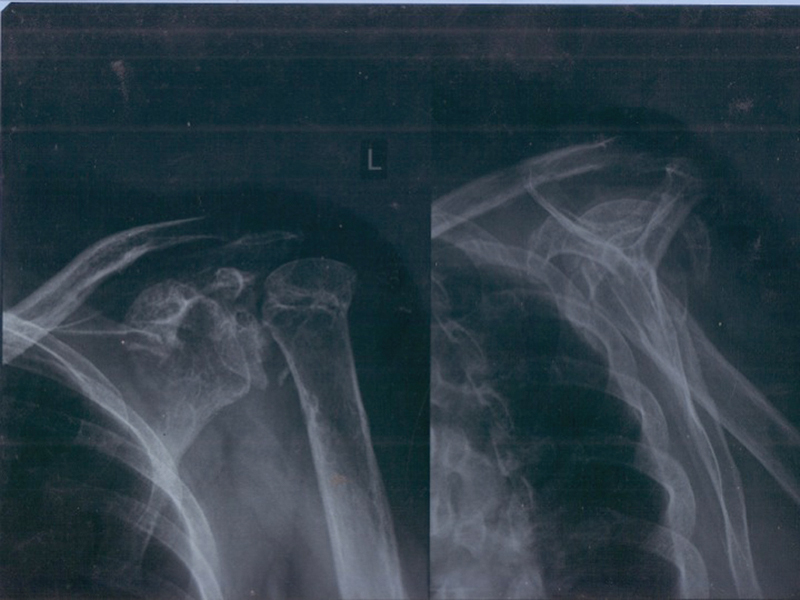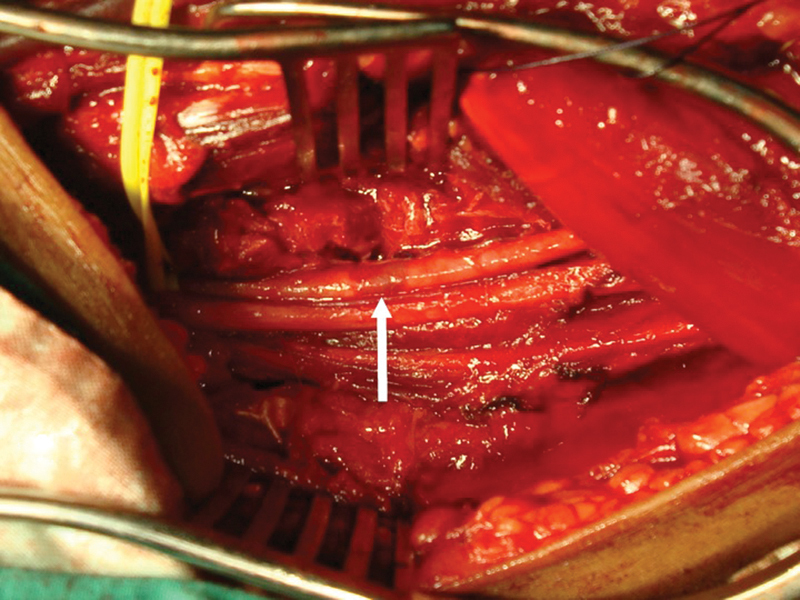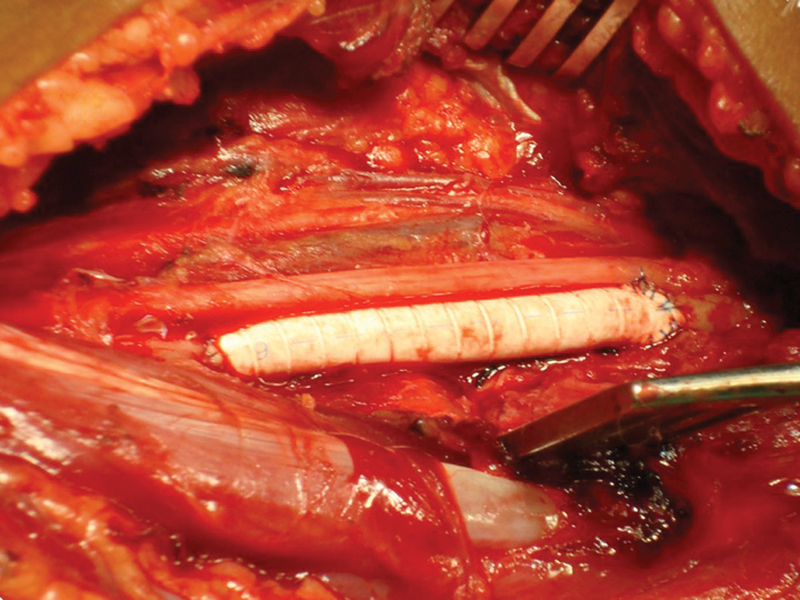Abstract
Injuries to the axillary artery from proximal humeral fractures are uncommon. There are only 66 such injuries reported across the world literature to date. We report an additional case of axillary artery injury. This case highlights the importance of maintaining a high index of suspicion to prevent diagnostic delay.
Keywords: vascular, trauma, fracture, dislocation
Fractures of the proximal humerus account for approximately 5% of all long bone fractures.1 Arterial injuries resulting from proximal humeral fractures are even less common. The world literature contains 66 instances where proximal humeral fractures cause arterial injuries documented in case reports1 2 3 4 5 6 7 8 9 10 11 12 13 14 15 16 17 18 19 20 21 22 23 24 25 26 27 28 29 or small series with less than 10 cases.30 31 32 33 34 35 36 37 38
These are important injuries because delayed diagnosis and treatment may result in serious sequelae including functional impairment, Volkmann ischemic contractures, and even limb loss. We report a case of axillary arterial injury resulting from a proximal humeral fracture and discuss the management of this uncommon disorder.
Case Report
A 68-year-old woman fell from a staircase at a height of 8 ft from the ground. She fell onto the left shoulder and immediately experienced severe incapacitating left shoulder pain. She sought attention at a community clinic. The shoulder was tender and swollen and mobility was impaired secondary to pain. Plain radiographs confirmed a fracture of the humeral neck (Fig. 1). The shoulder was immobilized with a plaster of paris cast and the patient transferred to a tertiary referral hospital for care.
Fig. 1.

Plain radiographs of the left shoulder demonstrating a fracture of the humeral neck.
She was stabilized in the emergency room and referred to the orthopedic service for a fractured neck of humerus. Although the ipsilateral upper limb was warm and pink, the radial and ulnar pulses were reduced in volume. The junior orthopedic resident removed the cast to examine the limb, but documented no further clinical information in the patient's clinical record. Postimmobilization radiographs were requested.
Four hours later, she was evaluated by the senior orthopedic resident who recognized clinical findings suggestive of limb ischemia: cool limb and reduced ipsilateral pulses. The cast was immediately removed and the vascular surgery team urgently summoned.
A duplex Doppler scan confirmed the absence of arterial flow at the ipsilateral brachial and radial arteries, but the axillary artery could not be assessed properly due to tenderness and edema at the area. The patient was taken emergently to the operating room for exploration, arterial repair, and joint stabilization.
Intraoperatively, a contused segment of the distal axillary artery was encountered, just as it continued to form the brachial artery (Fig. 2). There were no pulsations within the vessel at this point and no distal flow was detected.
Fig. 2.

Exposure of the left axillary artery. White arrows point to the contused segment of the distal axillary artery.
The shoulder joint was fixated with a short rod and wires and vessel exploration followed. The contused segment of axillary artery was excised after proximal and distal control. A large intimal flap was found to be obstructing the lumen in the injured segment. A 10-cm segment of proximal great saphenous vein was harvested from the ipsilateral thigh. The reversed vein was used to restore continuity as an interposition graft. There was poor flow, however, in this graft so a 10-cm segment of reinforced 5 mm Gore-Tex graft (W.L. Gore & Associates Inc, Flagstaff, AZ) was used to replace the interposed vein (Fig. 3). Primary anastomoses were completed with 6/0 polypropylene sutures, restoring pulsatile flow at the ipsilateral brachial and radial arteries.
Fig. 3.

Intraoperative photograph showing an interposition graft with a segment of reinforced 5 mm Gore-Tex graft.
The postoperative recovery period was uneventful. The limb remained viable and she was discharged on antiplatelets. At her follow-up clinic visit at 1 year, the limb remained viable with normal pulses but there was decreased range of motion at the shoulder. With explantation of the intramedullary rod 18 months postinjury and physical therapy, full range of shoulder movement returned. She remained asymptomatic with a viable limb at her 2-year clinic review.
Discussion
Axillary arterial injuries resulting from fracture dislocations of the proximal humerus are uncommon. Therefore, first responders do not readily entertain this as a differential and this contributes to diagnostic delay.
In addition, the signs of ischemia are usually attenuated because there is good collateral flow to the upper limb.2 10 20 39 Instead of frank ischemia, these patients usually have subtle signs such as reduced pulse volumes, capillary refill, and pulse oximetry readings.1 4 6 20 39 This prompted Brahmamdam et al2 to describe these upper limbs as “pink pulseless hands.” Our case highlights this as the diagnosis was made approximately 8 hours postinjury and only after clinical evaluation by four doctors.
The injury mechanism here was typical. Most fracture dislocations of the proximal humerus result from direct trauma after a fall onto the shoulder.5 The commoner signs of a fracture dislocation include painful swelling, bruising, loss of contour, and decreased range of motion.6 11 The fracture is usually easily evident on plain radiographs, although a minimally displaced fracture may be difficult to identify to the untrained eye.38
Once clinically suspected, arteriography is used to confirm and localize arterial injury.8 9 10 Conventional direct stick angiography may also allow endovascular repair of these injuries.8 9 However, arteriograms may not be universally available in trauma centers or hospital emergency rooms, especially in developing countries. In these cases, duplex Doppler ultrasound is an important adjunct to evaluate arterial flow,11 37 although it provides no avenue for percutaneous intervention.
This patient had no signs of frank ischemia despite the presence of an obstructing intimal flap. This is because the limb continued to be perfused through collateral flow by the scapular anastomoses. Although the presence of rich collaterals was the basis of early arguments for conservative management in these cases,37 most authorities now recommend exploration and revascularization to avoid the consequences of delayed ischemia, such as functional impairment, Volkmann contracture, and limb loss.10 12 13 14 32 34
The usual pathologic lesions encountered with fracture dislocations are luminal occlusions from intimal flaps13 14 15 or arterial thrombosis from intimal contusions.31 36 38 There have also been reports of rupture of the axillary6 9 18 31 or posterior circumflex humeral artery1 associated with these fractures. The presence of an intimal flap in this patient reinforces the position for mandatory exploration and repair.
In this case, an interposition graft with Gore-Tex was required. The gold standard operation for revascularization in these cases is interposition grafting using great saphenous vein5 33 or an arm vein31 as the conduit. In the absence of a suitable vein or with size mismatch, as was present in this case, interposition grafting using a prosthesis is a reasonable alternative.19
Conclusion
Clinicians should maintain a high index of suspicion for axillary artery injury when patients present with blunt trauma to the shoulder, coupled with signs suggestive of a proximal humeral fracture dislocation, and subtle signs of limb ischemia.
References
- 1.Gorthi V Moon Y L Jo S H Sohn H M Ha S H Life-threatening posterior circumflex humeral artery injury secondary to fracture-dislocation of the proximal humerus Orthopedics 2010333. doi: 10.3928/01477447-20100129-29 [DOI] [PubMed] [Google Scholar]
- 2.Brahmamdam P, Plummer M, Modrall J G, Megison S M, Clagett G P, Valentine R J. Hand ischemia associated with elbow trauma in children. J Vasc Surg. 2011;54(3):773–778. doi: 10.1016/j.jvs.2011.03.004. [DOI] [PubMed] [Google Scholar]
- 3.Matheï J, Depuydt P, Parmentier L, Olivie F, Harake R, Janssen A. Injury of the axillary artery after a proximal humeral fracture: a case report and overview of the literature. Acta Chir Belg. 2008;108(5):625–627. doi: 10.1080/00015458.2008.11680305. [DOI] [PubMed] [Google Scholar]
- 4.Soh R C, Tawng D K, Mahadev A. Pulse oximetry for the diagnosis and prediction for surgical exploration in the pulseless perfused hand as a result of supracondylar fractures of the distal humerus. Clin Orthop Surg. 2013;5(1):74–81. doi: 10.4055/cios.2013.5.1.74. [DOI] [PMC free article] [PubMed] [Google Scholar]
- 5.Yagubyan M, Panneton J M. Axillary artery injury from humeral neck fracture: a rare but disabling traumatic event. Vasc Endovascular Surg. 2004;38(2):175–184. doi: 10.1177/153857440403800210. [DOI] [PubMed] [Google Scholar]
- 6.Adovasio R, Visintin E, Sgarbi G. Arterial injury of the axilla: an unusual case after blunt trauma of the shoulder. J Trauma. 1996;41(4):754–756. doi: 10.1097/00005373-199610000-00028. [DOI] [PubMed] [Google Scholar]
- 7.Sukeik M, Vashista G, Shaath N. Axillary artery compromise in a minimally displaced proximal humerus fracture: a case report. Cases J. 2009;2:9308. doi: 10.1186/1757-1626-2-9308. [DOI] [PMC free article] [PubMed] [Google Scholar]
- 8.Kumar R M, Reddy S S, Sharma R, Mahajan R, Talwar K K. Endovascular repair of a traumatic axillary artery pseudoaneurysm. Cardiovasc Intervent Radiol. 2009;32(3):598–600. doi: 10.1007/s00270-009-9543-5. [DOI] [PubMed] [Google Scholar]
- 9.Manák P, Klein J. Axillary artery injury in closed fracture of the humeral neck. Acta Univ Palacki Olomuc Fac Med. 1996;140:87–88. [PubMed] [Google Scholar]
- 10.Steinberg I, Maitem A N. False aneurysm following fracture of limb. Angiographic study. N Y State J Med. 1974;74(11):2024–2026. [PubMed] [Google Scholar]
- 11.Benedetti Valentini M, Farsetti P, Martinelli O, Laurito A, Ippolito E. The value of ultrasonic diagnosis in the management of vascular complications of supracondylar fractures of the humerus in children. Bone Joint J. 2013;95-B(5):694–698. doi: 10.1302/0301-620X.95B5.31042. [DOI] [PubMed] [Google Scholar]
- 12.Calder F R, Gwyther S J, Loosemore T M. Digital gangrene: an unusual late complication of non-union of a proximal humeral fracture. Injury. 1997;28(9-10):695–696. doi: 10.1016/s0020-1383(97)00059-4. [DOI] [PubMed] [Google Scholar]
- 13.Jensen B V, Jacobsen J, Andreasen H. Late appearance of arterial injury caused by fracture of the neck of the humerus. J Trauma. 1987;27(12):1368–1369. doi: 10.1097/00005373-198712000-00010. [DOI] [PubMed] [Google Scholar]
- 14.Puri R, Clark J, Corkery P H. Axillary artery damage following a closed fracture of the neck of the humerus—a case report. Injury. 1985;16(6):426–427. doi: 10.1016/0020-1383(85)90066-x. [DOI] [PubMed] [Google Scholar]
- 15.van Embden D, Rhemrev S J. A woman with a painful shoulder and cold hand [in Dutch] Ned Tijdschr Geneeskd. 2010;154:A791. [PubMed] [Google Scholar]
- 16.Shuck J M, Omer G E Jr, Lewis C E Jr. Arterial obstruction due to intimal disruption in extremity fractures. J Trauma. 1972;12(6):481–489. doi: 10.1097/00005373-197206000-00005. [DOI] [PubMed] [Google Scholar]
- 17.Adovasio R, Visintin E, Sgarbi G. Arterial injury of the axilla: an unusual case after blunt trauma of the shoulder. J Trauma. 1996;41(4):754–756. doi: 10.1097/00005373-199610000-00028. [DOI] [PubMed] [Google Scholar]
- 18.van Arkel E R, Tordoir J H, Arens H J. A proximal humeral fracture, complicated by a pseudoaneurysm—a case report. Acta Orthop Scand. 1998;69(2):194–195. doi: 10.3109/17453679809117627. [DOI] [PubMed] [Google Scholar]
- 19.Edelmann K, Dvorák J, Kopp L, Obruba P. Proximal humeral fracture complicated by axillary artery lesion—a case review [in Czech] Rozhl Chir. 2010;89(9):473–476. [PubMed] [Google Scholar]
- 20.Carter S J, Germann C A, Dacus A A, Sweeney T W, Perron A D. Orthopedic pitfalls in the ED: neurovascular injury associated with posterior elbow dislocations. Am J Emerg Med. 2010;28(8):960–965. doi: 10.1016/j.ajem.2009.05.024. [DOI] [PubMed] [Google Scholar]
- 21.Wenger J D, Olsson C J. Acute limb ischemia after a proximal humeral epiphyseal fracture: intraoperative findings of an illustrative vascular lesion. J Shoulder Elbow Surg. 2011;20(3):e1–e3. doi: 10.1016/j.jse.2010.10.025. [DOI] [PubMed] [Google Scholar]
- 22.Jalili A, Mazhar F N, Ghahramani M H, Bahrabad M. Axillary artery injury with proximal humerus epiphyseal separation: a rare case report. Med J Islam Repub Iran. 2012;26(4):189–191. [PMC free article] [PubMed] [Google Scholar]
- 23.Seagger R M, Kitson J. A rare combination of an axillary artery and brachial plexus injury due to a proximal humeral fracture. Int J Shoulder Surg. 2009;3(3):71–73. doi: 10.4103/0973-6042.59975. [DOI] [PMC free article] [PubMed] [Google Scholar]
- 24.Mouzopoulos G, Lassanianos N, Mouzopoulos D, Tzurbakis M, Georgilas I. Axillary artery injury associated with proximal humerus fractures. Vasa. 2008;37(3):274–277. doi: 10.1024/0301-1526.37.3.274. [DOI] [PubMed] [Google Scholar]
- 25.Gallucci G, Ranalletta M, Gallucci J, De Carli P, Maignon G. Late onset of axillary artery thrombosis after a nondisplaced humeral neck fracture: a case report. J Shoulder Elbow Surg. 2007;16(2):e7–e8. doi: 10.1016/j.jse.2006.04.009. [DOI] [PubMed] [Google Scholar]
- 26.McLaughlin J A, Light R, Lustrin I. Axillary artery injury as a complication of proximal humerus fractures. J Shoulder Elbow Surg. 1998;7(3):292–294. doi: 10.1016/s1058-2746(98)90058-1. [DOI] [PubMed] [Google Scholar]
- 27.Smyth E H. Major arterial injury in closed fracture of the neck of the humerus. Report of a case. J Bone Joint Surg Br. 1969;51(3):508–510. [PubMed] [Google Scholar]
- 28.Laverick M D, D'Sa A A, Kirk S J, Mollan R A. Management of blunt injuries of the axillary artery and the neck of the humerus: case report. J Trauma. 1990;30(3):360–361. doi: 10.1097/00005373-199003000-00022. [DOI] [PubMed] [Google Scholar]
- 29.Hoffheinz H J. Injuries of axillary artery in fractures and dislocations in shoulder area [in German] Monatsschr Unfallheilkd. 1975;78(3):129–133. [PubMed] [Google Scholar]
- 30.Marty B, Simmen H P, Neff U, Habegger R. Subcapital humerus fracture with lesion of the axillary artery. 2 case reports and review of the literature [in German] Unfallchirurg. 1996;99(2):154–157. [PubMed] [Google Scholar]
- 31.Berga C, Prat S, Ninot S, Sanjuán M A, Mulet J. The arterial complications of closed injuries to the shoulder girdle [in Spanish] Angiologia. 1992;44(4):139–143. [PubMed] [Google Scholar]
- 32.Seitz J, Valdés F, Kramer A. Acute ischemia of the upper extremity caused by axillary contused trauma. Report of 3 cases [in Spanish] Rev Med Chil. 1991;119(5):567–571. [PubMed] [Google Scholar]
- 33.Lim E V, Day L J. Thrombosis of the axillary artery complicating proximal humeral fractures. A report of three cases. J Bone Joint Surg Am. 1987;69(5):778–780. [PubMed] [Google Scholar]
- 34.Barra J A, Le Saout J, Gaultier Y. Late signs of vascular complications of closed trauma of the shoulder (author's transl) [in French] J Chir (Paris) 1978;115(3):151–157. [PubMed] [Google Scholar]
- 35.Theodorides T, de Keizer C. Injuries of the axillary artery caused by fractures of the neck of the humerus. Injury. 1976;8(2):120–123. doi: 10.1016/0020-1383(76)90045-0. [DOI] [PubMed] [Google Scholar]
- 36.Zhang Q, Wang S, Tang C, Chen W, Zhang Y, Chen L. Axillary artery lesions from humeral neck fracture: A study in relation to repair. Exp Ther Med. 2013;5(1):328–332. doi: 10.3892/etm.2012.775. [DOI] [PMC free article] [PubMed] [Google Scholar]
- 37.Modi C S, Nnene C O, Godsiff S P, Esler C N. Axillary artery injury secondary to displaced proximal humeral fractures: a report of two cases. J Orthop Surg (Hong Kong) 2008;16(2):243–246. doi: 10.1177/230949900801600223. [DOI] [PubMed] [Google Scholar]
- 38.Maweja S, Sakalihasan N, Van Damme H, Limet R. Axillary artery injury secondary to anterior shoulder dislocation: report of two cases. Acta Chir Belg. 2002;102(3):187–191. doi: 10.1080/00015458.2002.11679291. [DOI] [PubMed] [Google Scholar]
- 39.Williams E W, Cawich S O, James M. et al. Penetrating neck trauma and the aberrant subclavian artery. West Indian Med J. 2007;56(3):288–293. doi: 10.1590/s0043-31442007000300021. [DOI] [PubMed] [Google Scholar]


